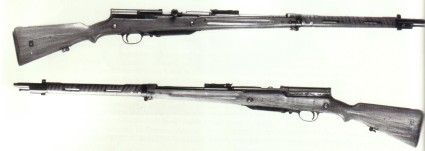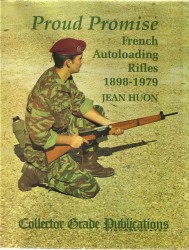CRUFFLER.COM
presents
HISTORIC
FIREARM OF THE MONTH,
June
2000:
 |
 |
 |

Image Credit: Huon, Jean, Proud Promise: French Autoloading Rifles 1898 - 1979, Collector Grade Publications (Cobourg, Ontario: 1995) Page 42 |
Type:
Self Loading Rifle
System of Operation: Gas Caliber: 8x50mmR Lebel Capacity: 5 rounds Sights: Blade front, v-notch rear Length: 52" Weight (unloaded): 11.5 lbs Barrel: 22.8" |
In August 1914 France entered into one of the bloodiest conflicts in history, the First World War. Despite an impressive pre-war autoloader development program, the French military did not possess a self-loading rifle ready for issue to front line troops. As a result, the poilus (literally "bearded ones;" the French equivalent of "GI") of the French Army went to war armed with a collection of repeating bolt action rifles that had been designed from fifteen to twenty-eight years previously. The war on the ground rapidly became one of position, where both sides dug elaborate trench systems. As a result of the trench, barbed wire, and the machine gun, it was no longer possible to send out the cavalry to scout the enemy's positions. However, intelligence on enemy positions was still vital to any operation. Fortunately for the general staff, just as the horse cavalry's intelligence gathering days came to a close, the airplane appeared to fill in the gap.
High above the Western Front, German and French observers began to carry the shooting war to the skies. The bolt action rifles and carbines failed to prove effective. What was needed was a weapon that would provide a high rate of fire for the brief periods when enemy aircraft were in range. The aircraft of the early war period proved incapable of withstanding the recoil forces of contemporary machineguns, and so both sides turned to self loading carbines. The problem was that in 1914, none of the belligerents had issued a lightweight self loading rifle. As a result, the French turned to commercial sporting arms manufacturers, notably Winchester in the United States.
| The French purchased a large number of Winchester Model 1907 and 1910 self loading carbines in calibers .351 and .401 Winchester Self Loading respectively for issue to air crews. These blowback |

Winchester Model 1907 Image Credit: Huon, Jean, Proud Promise: French Autoloading Rifles 1898 - 1979, Collector Grade Publications (Cobourg, Ontario: 1995) Page 35 |
Many in the French military establishment expressed regret that many promising autoloading rifle projects had been discontinued in 1913 based on the premise that a nation simply did not begin a massive rearmament program when war was imminent. Among the reasons for the programs' discontinuance was that all the proposed rifles used new high performance rimless cartridges. Not one was compatible with the standard French rifle round, the 8x50mmR Lebel. By the time the General Staff got around to realizing that a self loading rifle using the Lebel cartridge would be a positive step, no such rifle was ready. Fortunately for the French, arms designers Ribeyrolles, Sutter, and Chauchat were able to quickly produce prototypes.
True to French military tradition, the new rifle was presented as a "kit," ostensible designed to convert France's huge stockpiles of obsolete M1886-93 tube magazine Lebels into self loading rifles. However, only the stock, forearm, and stock fittings were used. As the M1886-93 Lebel was no longer in production, barrels from the M1916 Mannlicher-Berthier bolt action rifle were used. A gas impingement mechanism was added, with the piston assembly lying in the tube magazine trough in the forearm. A new receiver and magazine were developed from pre-war prototypes designed by Chauchat and Sutter. The rifle was officially adopted in May, 1916 as the Fusil Automatique Modele 1917. Technical and production problems delayed the beginning of series manufacture until April 1917.
THE
STOPGAP
The
need for a self loading rifle was finally acknowledged, but the first issues
of the new rifle were almost a year away. To fill the need in the
interim, the French decided to produce a pre-war design, the A6, designed
by Etienne Meunier as the 7mm M1916. A number of the M1916's were
made by the three French state arsenals (Chatellerault - MAC, St. Etienne
- MAS, and Tulle - MAT).

Meunier M1916 Rifle Image Credit: Huon, Jean, Proud Promise: French Autoloading Rifles 1898 - 1979, Collector Grade Publications (Cobourg, Ontario: 1995) Page 20 |
The M1916 had a one-piece pistol grip stock which ended halfway up the barrel. The barrel was surrounded by a tubular wooden handguard between the lower and upper bands. The handguard also acts as a cooling jacket with lateral ventilation grooves plus a large dorsal opening. The |
As noted above, when the rifle is fired, the barrel recoils, carrying the bolt assembly with it. The bolt is rotated by means of a cam groove in the bolt carrier, and is thus unlocked. The barrel then stops its rearward movement while the bolt continues to the rear, completing the extraction and ejection sequence. The barrel returns forward while the bolt recocks the firing mechanism by riding over the hammer. The bolt group then moves forward, stripping a new round into the chamber and locking the bolt into place. The M1916 fired a 139 grain 7mm bullet from a 56.95mm case at a muzzle velocity of some 2,800 fps.
THE
M1917 ENTERS PRODUCTION
Production
of the M1917 began on April 1, 1917 among several manufacturers:
The Manufacture Nationale d'Armes de Tulle (MAT) made the receiver, barrel,
and triggerguard. The Manufacture Nationale d'Armes de Chatellerault
(MAC) made the trigger housing. The Manufacture Nationale d'Armes
de St. Etienne (MAS) made the bolt, bolt carrier, piston, gas cylinder,
stock and barrel. The Manufacture d'Armes de Paris, a branch of Fabrique
Nationale made the cocking lever, the magazine housing, and the follower.
The rifles were assembled at MAS (one hundred rifles were assembled at
MAC), and then supplied to the government for issue to the troops in the
field. In units equipped with the M1917, sixteen were distributed
per company. They were supplied to platoon leaders and designated
marksmen chosen because of their ability to carry out the necessary mechanical
repairs autoloaders required.
SYSTEM
DESCRIPTION
The
M1917 rifle used the stock of the M1886-93 Lebel. The stock was secured
by two metal screws going vertically through the wood, from the trigger
housing to the receiver. The trigger housing is a simple affair that
contains the triggerguard and the trigger. The upper part of the
receiver is tubular, the lower part rectangular. The bolt locking
slots are machined into the forward part of the tube. There is a
bolt catch which allows the bolt to be locked to the rear by holding the
operating rod to the rear. The left side of the receiver is marked
"Manufactures Nationales/MAS 1918 Mle. 1917." The bolt is cylindrical
and made up of two parts, the bolt carrier and the bolt. The bolt
locks by means of two opposing series of three lugs at the front and two
lugs at the rear which slide in the two channels in the bolt carrier.
The bolt houses the extractor and firing pin channel.
The barrel is that of the Mannlicher-Berthier M1916 bolt action rifle. It is 8mm in caliber and has four grooves, right hand twist of one turn in 9.5". The gas port is 5.5" from the muzzle, and may be adjusted by means of a regulating screw. The gas cylinder is under the barrel, inside the forearm. The gas piston extends rearward, becoming the operating rod, which slides on the right side of the receiver behind the lower band. There is a flap that covers the ejection port when the operating rod is in the forward position.
The magazine contains a Mannlicher style clip. In a fit of misguided brilliance, none of the designers saw fit to make the clip interchangeable with that of the French Army's standard rifle, the M1916 Mannlicher-Berthier. The clip differs from that of the Berthier in that the bottom is flat and it does not have a locking device. The feed mechanism comprises the follower, two links, and a cam. These are pushed upward by the follower tube plunger. A magazine housing of stamped steel protects the clip and feed mechanism. The housing is hinged at the front, and opens from the rear. It is latched by a small flat spring riveted to the rear.
The front sight is triangular in cross section and rests on a base welded to the front of the barrel. The rear sight is mounted on a ring which circles the barrel. With the rear sight leaf folded, the rifle is graduated for 250 meters, with incremental steps from 400 to 800 meters. With the leaf raised, it is graduated from 900 to 2,400 meters. The front of the stock is composed of the forearm which is held in place by a lower band with a sling ring, and an upper band with a straight stacking rod. There is a handguard covers the barrel from forward of the rear sight to just forward of the lower band.
SYSTEM
OPERATION
Once
the trigger is pressed, the sear disengages, releasing the hammer to strike
the firing pin and fire the rifle. As the bullet travels down the
barrel, it passes the gas port. A portion of the propellant gas enters
the gas cylinder and forces the piston to the rear. Rearward travel
of the barrel compresses the recoil spring and moves the cocking lever
to the rear. The cocking lever brings the bolt carrier to the rear,
causing the bolt to rotate 90 degrees as it follows the cam in the bolt
carrier. Once rotated, the bolt disengages from the receiver, and
moves to the rear with the carrier, extracting and ejecting the empty case.
As the bolt recoils, the upper hammer hook is forced into the disconnecting sear. The disconnecting sear holds the hammer while the case is ejected. When the shooter releases the trigger, the disconnecting sear transfers the cocked hammer to the trigger sear. As an aside, this is the same system that the French used thirty years later on the MAS 49, and that the US used on the M16 rifle.
Under the combined pressure of the cam and links, the follower pushes the ammunition upwards and presents the upper cartridge to the boltface for loading.
VARIANTS
M1917 Short Rifle: The only difference between the M1917 short rifle and a standard M1917 were a shorter barrel, a larger upper barrel band, and a pointed and curved stacking rod. The rear sight was identical. The Short Rifle was made in quantity for test and evaluation purposes.
M1917 Musket: From the short M1917 was developed what may be called the world's first self loading assault weapon. (A weapon designed specifically for offensive infantry use as opposed to the later misnomer applied by the US media.) The barrel measured 17.7", and was fitted with a single slot muzzle compensator. The front of the gas cylinder can be disassembled. It is slightly longer than the barrel and is made to receive a tubular bayonet. There are two symmetrical handguards around the barrel.

M1917 Musket Image Credit: Huon, Jean, Proud Promise: French Autoloading Rifles 1898 - 1979, Collector Grade Publications (Cobourg, Ontario: 1995) Page 49 |

Fusil Automatique Modele 1918 Image Credit: Huon, Jean, Proud Promise: French Autoloading Rifles 1898 - 1979, Collector Grade Publications (Cobourg, Ontario: 1995) Page 49 |
EPILOGUE
The M1917
was eventually adapted into the M1918 rifle, a perfection of the M1917
short rifle, which gave excellent service in the Moroccan Rif War of 1921
- 1926. More importantly, the M1917 deserves a significant place
in the pantheon of firearms history. It was the first general issue
self loading rifle to be adopted by a major military power, and contained
features that were seminal in its field. Features first found on
the M1917 would later find their way into many later, more widely known,
more widely produced designs. Like a venerable patriarch, the
M1917 deserves recognition and respect as one of the most important and
influential military longarms ever devised.
BIBLIOGRAPHY
Huon, Jean, Proud Promise: French Autoloading Rifles, 1898 - 1979, (Collector Grade Publications, Inc., Cobourg, Ontario: 1995)
Proud
Promise is available from IDSA Books. Click on the image to order:
